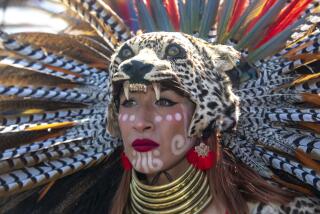Troupe’s traditions more compelling than program
- Share via
Along the southern tip of India live a people who believe that elaborate physical and mental preparation can bring them to a spiritual flashpoint in which deities and ancient heroes will take over their bodies and dance.
Excerpts from their rites of possession came to the UCLA Live series Friday in a program titled “Gods, Goddesses and Ancestors: Masked Rituals of Kerala, India.” The performers (all male) belong to eight families who are guardians of this tradition, called theyyam, the word that has come to define the sacred ceremonies in which blessings result from the union of human bodies and divine energies.
In a sense, the comprehensive program notes and spoken introductions proved more satisfying than the performance itself, because they connected the audience to the essential spirituality of theyyam that the music and dancing alone seldom conveyed.
For instance, you could read about the public offerings made during the ritual and other interactions of the transformed performers and the villagers, who ask questions and receive specific benedictions.
Unfortunately, religious strictures reportedly made all such interactions impossible on tour, so the chief insights into the crucial belief system supporting theyyam came only from brief passages involving the devout Haridasan Kuniparambil at a side altar.
Otherwise, what the Royce Hall audience experienced in an uninterrupted two hours consisted of painfully loud, abrasive music from four drums and one blaring reed, a few interludes of intriguing choral singing or chant, plus three extended dance solos.
Richer in color than context, these solos began with Babu Kundilarambath in detailed body paint evoking a fabled warrior in a dance full of kicks, flips, turning leaps and other moves related to traditional martial arts, sometimes involving swords, a shield or a drum strapped around his waist.
Another warrior dance found Ratheesh Payyanmarkandi circling a table that held 64 candles, wearing a costume dominated by large stiff disks around his waist and a number of glittering cloth disks that projected from his pantaloons like gills.
Marching, skipping and spinning, as well as boldly swinging his weapons, he ended his dance with a formal seated bow in four directions and the removal of his ornate headdress.
The most spectacular solo placed Lakshmanan Kundilarambath inside an enormous tent-like red and gold costume with a high semicircular headdress and a wide, stiff skirt. Only his face, hands and feet protruded, but he managed to achieve a surprising range of motion (sways, turns, hops) in the role of a protective goddess.
The goddess solo used a portable curtain held by attendants, as in the kathakali dance-drama from the same region, along with intricate character pantomime. None of this was enough for many ticket-holders, who left throughout the performance.
Ravi Gopalan Nair served as artistic director for this first U.S. tour of theyyam artists.
More to Read
The biggest entertainment stories
Get our big stories about Hollywood, film, television, music, arts, culture and more right in your inbox as soon as they publish.
You may occasionally receive promotional content from the Los Angeles Times.









